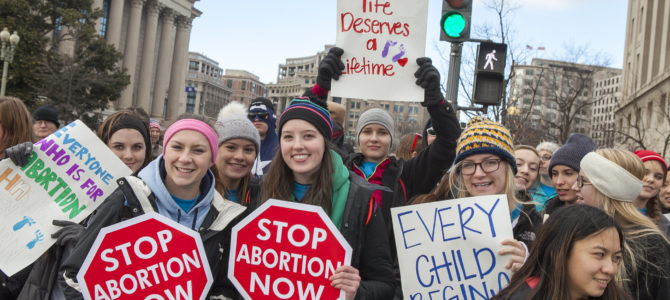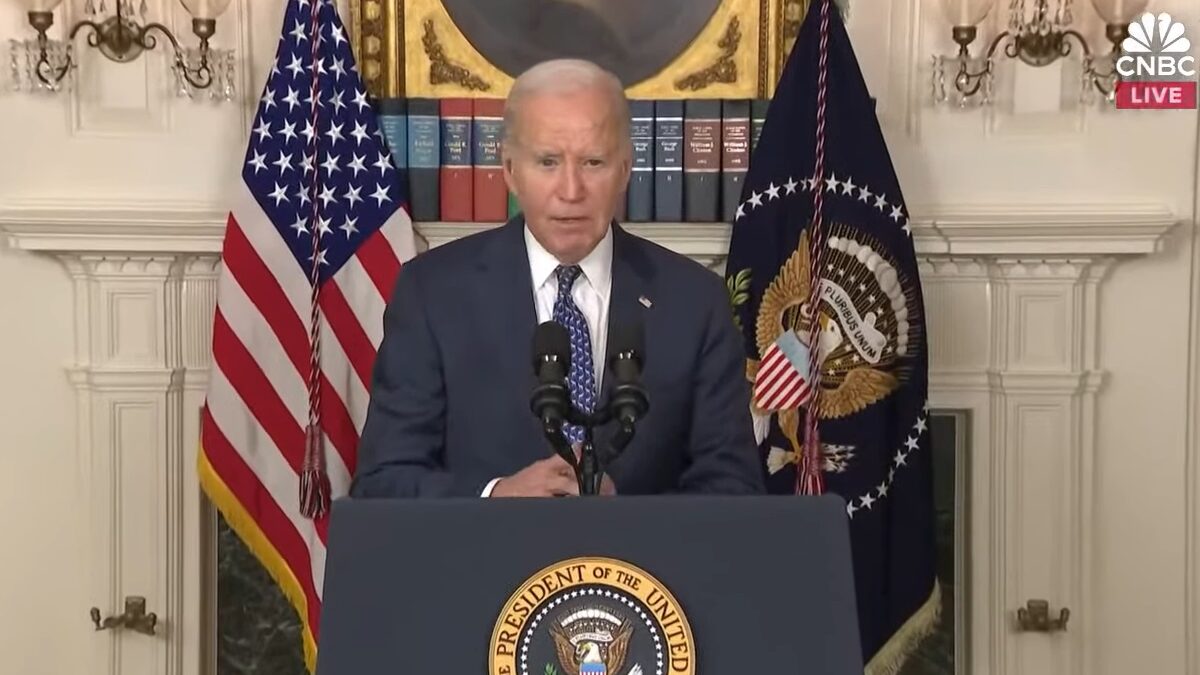
The pro-life movement may soon find itself at a defining moment. Late last week, the state of Mississippi filed its brief in Dobbs v. Jackson Women’s Health Organization. The case concerns a Mississippi abortion law passed in 2018 that prohibits abortions (with limited exceptions) after 15 weeks of pregnancy.
Mississippi Attorney General Lynn Fitch’s measured and persuasive defense of the statute argued “abortion jurisprudence has placed this Court at the center of a controversy that it can never resolve.” It urged the justices to return “abortion policy to the states – where agreement is more common, compromise is more possible, and disagreement can be resolved at the ballot box.”
Under the Supreme Court’s current jurisprudence, which stems from its 1973 decision in Roe v. Wade, the challenged Mississippi law is plainly invalid. Under Roe, as modified in 1992 by the Supreme Court’s decision in Casey v. Planned Parenthood, a state may not prohibit abortion before the point of fetal viability, as Mississippi has done here.
Fetal viability is usually reached about 23 or 24 weeks into a pregnancy, although it may be reached at 22 weeks in places where standards of maternal health care are higher. Obviously, 15 weeks into a pregnancy is far sooner than the normal point of viability. If the Supreme Court nonetheless upholds the Mississippi law (as some expert commentators forecast it will do), then the architecture of abortion law, erected over the nearly half-century since Roe, would be in danger.
The reasons the Supreme Court should deconstruct that architecture are extremely powerful. There is, as Mississippi argues, no tenable basis for it in the Constitution’s language, structure, purposes, or history. Constitutional rules and norms derive from the consensus and practice of an overriding majority of the states and the people.
Nearly half a century after Roe, it is unarguable that there never has been, and there is not now, anything like a settled national consensus on abortion. The Supreme Court has made up constitutional rules out of thin air.
But an outcome that dismantles Roe and Casey is by no means a certainty. There are at least two other possible outcomes – two “compromises,” in addition to a pro-life “victory.”
‘Compromises’
First, the Supreme Court might try to fashion a “compromise” that embeds the “principles” of Roe even more deeply into its constitutional law. Under the leadership of three “moderate” Republican appointees — Justices Sandra Day O’Connor, Anthony Kennedy, and David Souter — that is just what the court attempted to do in Casey in 1992.
The “compromise” predictably proved to be unstable, which is why, more than a quarter of a century later, the Supreme Court is facing the issue of abortion once again. Each of these justices has since retired. But the court might unwisely persist on their course.
A second compromise is also possible, and more likely. The court might uphold the Mississippi law and allow states to regulate or prohibit abortions after a baby becomes capable of feeling pain from the procedure. That point in the pregnancy might be set at or around 15 weeks, perhaps leaving the states some latitude for judgment.
Such an outcome might seem like a clean sweep for pro-life forces. It would not be one, however, if the court also determined that abortions before that point remained entirely permissible. The overwhelming majority of abortions occur in the first 14 weeks of pregnancy. A decision like that would therefore leave states powerless to restrict most abortions.
The result: A pro-life victory, but a hollow one, if the new “constitutional” line proved to be politically acceptable to most voters, as might well be the case. Worse, a ban on late-term abortions that exempts abortions for fetal “abnormalities” including Down syndrome would preserve the system we have today, except by other rules.
‘Victory’
But let’s return to the possibility that the Supreme Court deals a death blow to the Roe/Casey policy, and gives states the power to protect unborn human life even from the moment of conception, if they chose to define that point as the beginning of human life. Would that not be a stunning victory for pro-life forces? Yes — or, rather, yes, but…
What would happen if the court returned the question of whether to legalize abortion back to the states? This would be a welcome development, to be sure. Yet abortion on demand may still exist, by legislation, in many parts of the country.
Extremist states would allow abortion up until — or even slightly after — birth. Most other states might allow abortion very early in a pregnancy, when (as we’ve noted) the vast majority of abortions occur.
What if, say, most states enacted laws permitting abortion for any reason up to 13 weeks into a pregnancy, but restricted abortions thereafter? In practical terms, Dobbs would not have made much difference, except in some regions. But that is not the only, or even the most significant, challenge the pro-life movement would face after the Supreme Court victory we are imagining here.
A Constitutional Ban on Abortion?
The pro-life movement would still have to address whether to pursue a new litigation strategy of arguing for a constitutional ban on state (or federal) laws permitting abortion. That objective would go well beyond merely reversing Roe and handing off the abortion question to legislatures (and ultimately, voters). It would not be so much the reversal of Roe as Roe in reverse.
Expect the debate over that strategy to dominate the internal conversations of the pro-life movement for some time — probably years. Indeed, as Steve Jacobs’s article “The Supreme Court Shouldn’t Return Abortion to the States, But Ban It” in The Federalist shows, the conversation is already well underway.
Jacobs argues strenuously that the movement should seek the “constitutionalization” of a general nationwide ban on abortion. The argument is that the Constitution protects human life whenever it exists – and an unborn fetus is a human life, entitled to government protection from anyone who would kill it.
Should the pro-life movement mobilize around this argument? Whether this is a sound strategy depends in part on how deeply you believe the country has become enmeshed in a post-constitutional regime. Roe and Casey are paradigms of post-constitutional law.
They are unmoored from the text of the Constitution, its structure, or its purposes. They do not reflect the nation’s historic traditions nor its prevailing conception of which freedoms are fundamental. They are arbitrary impositions by a narrow and unrepresentative judicial elite attentive only to the wishes of a minority of citizens. They are junk law. If the Supreme Court affirms them, it will be to its indelible discredit.
If one accepts the view that the true Constitution is irretrievably gone and we live in a post-constitutional order, then yes, the pro-life movement could well promote the constitutionalization of an across-the-board ban on abortion. If the left can wreak havoc in a post-constitutional world, the right can play the same game. Bring on Roe-in-reverse.
But what course should pro-lifers pursue if they have not wholly given up hope in the restoration of a constitutional order?
Returning Abortion Policy to the States?
Under the framework of the Constitution, the basic answer is simple: abortion policy is generally left to the states and their people. That was commonly assumed before Roe. Mississippi’s brief affirms that history and urges a return to the bedrock rule. If the Supreme Court agrees, it would thereafter generally uphold state laws that allow, encourage or fund abortion, as well as laws that regulate or prohibit abortion.
The Constitution is in fact agnostic about abortion. True, Section 1 of the Fourteenth Amendment protects “persons” against deprivation of life without due process of law. But are the unborn “persons” in a constitutional sense?
Scholars like Michael Paulsen (and more recently John Finnis) have argued with considerable erudition that the answer might be yes. Two amicus briefs filed in Dobbs by state legislators and policy organizations defend the view that prenatal persons are constitutionally protected (and even that states have a constitutional obligation to protect them).
Supreme Court case law has long determined that a business corporation, which is certainly not a natural person, is a person in the constitutional sense. So a “constitutional” person does not necessarily equal a human being who has been born and remains alive.
But it is questionable whether an unborn child is a “person” in the constitutional sense. Section 2 of the Fourteenth Amendment provides for congressional representation based on the number of “persons” in a state. In relevant part, it says: “Representatives shall be apportioned among the several states according to their respective numbers, counting the whole number of persons in each state.”
Were the unborn ever counted as persons in a census of a state’s population? If not, could someone be a “person” in Section 1 but not in Section 2 – or is it more likely that the term means the same in both sections?
Moreover, even if the unborn could be considered constitutional “persons,” there would remain a question whether a state, in allowing them to be aborted, was “depriving” them of life without due process of law. Abortion is an act of private violence, not state action.
Is a state “depriving” the unborn of life by deciding not to intervene affirmatively to save them? It does not seem so. In general, under the Due Process Clause, the states have no duty to save an unborn child – or anyone else. The Due Process Clause generally follows the broad contours of the traditional common law, and under that law, there is no “duty to rescue,” except where some special relationship between victim and rescuer exists.
Abortion and Slavery
Abortion is often, rightly, compared to slavery. Both evils reflect a refusal to acknowledge and respect the full humanity of a class of people who are indeed human.
Also, the debate over the constitutionality of abortion in some ways mirrors the debate over the constitutionality of slavery. Until the Thirteenth Amendment was ratified as a consequence of the Civil War, the Constitution had never mentioned slavery in express terms (although it made implicit references to it).
Before the war, there were bold and imaginative abolitionist legal theorists who had argued that the Constitution did not leave slavery to the states, but impliedly forbade it nationally, or at least empowered Congress to do so. For example, they made the argument that slavery was incompatible with the “Republican form of government” that the Constitution guaranteed.
Sadly, the abolitionist view was probably not a sound interpretation of the (original) Constitution. As legal scholars have noted, the Constitution acknowledged state control over slavery. Even opponents of slavery like Abraham Lincoln admitted as much.
In the then-prevailing view, slavery was the price that had to be paid for the Union. Where slavery existed under state law, the Union was powerless to undo it, unless perhaps the federal Treasury compensated slave owners for confiscating their “property” — an amount that would have been astronomical.
Our federalism tolerates the choice of abortion by a state and its people — just as it tolerates their rejection of abortion, and once tolerated their choice for slavery.
Where Should the Pro-Life Movement Go?
Pro-life advocates should not want to replace one form of judicial tyranny with another. After all, what is to stop a future band of judicial tyrants supplanting Roe-in-reverse with reverse-Roe-in-reverse?
Judicial tyranny begets protracted resistance, as the fevered political aftermath of Roe and Casey shows. We should not readily wish to recapitulate that process for decades longer.
We are a pluralistic nation. We have few common substantive values. Indeed, we are finding it increasingly difficult to agree even on neutral procedural rules. And we most certainly do not have a consensus on abortion.
The Constitution should be understood to recognize our inescapable value of pluralism and to give it room to breathe. Roe was not just wrong as a legal matter but was also untrue to the value pluralism that is in our nation’s DNA. It imposed the value perspective of what was and remains a minority. That is why it remains so unstable a decision half a century later.
The wonderful and humane energy of the pro-life movement should be rededicated to creating a national consensus on abortion, not to agitating for another judicial coup like Roe. Truth, science, and humanity are on its side.
And the moral case against abortion has become ever more compelling over time. When Roe was decided, we could not see imagery of infant life in the womb in nearly as much detail as we now can. That scientific advance has transformed our understanding of prenatal life. Further scientific advances will do the same.
The pro-life movement should be sponsoring a pro-life constitutional amendment. It will take decades of hard work to build the coalition that will ratify it. But it is worth the effort.









